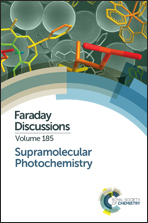Parameters influencing the photo-induced electron transfer from tryptophan-containing peptides to a RuII complex: a systematic study†
Abstract
Ruthenium(II) polyazaaromatic complexes have gained interest in recent decades as biomolecular tools, especially in the development of new phototherapeutic agents. These light emissive Ru complexes based on π-deficient ligands were first designed to allow a photo-induced electron transfer (PET) with the guanine base in DNA since their 3MLCT state is highly photo-oxidizing. Later the field of research was extended to proteins with the highlighting of a PET process with the tryptophan residue. This paper reports the kinetics of the luminescence quenching of [Ru(TAP)2phen]2+ by several selected peptide sequences containing at least one tryptophan residue. By using a peptide library we highlight the important parameters influencing the kinetics of the photo-electron transfer process, such as the net electrostatic charge and the number of tryptophan residues. The best peptide candidates were selected to study the formation of photo-products by MALDI-ToF mass spectrometry. A high photoreactivity of the [Ru(TAP)2phen]2+ complex was observed and multiple photoadducts were characterized, among them inter-peptidic adducts as well as intra-peptidic adducts.
- This article is part of the themed collection: Supramolecular Photochemistry

 Please wait while we load your content...
Please wait while we load your content...